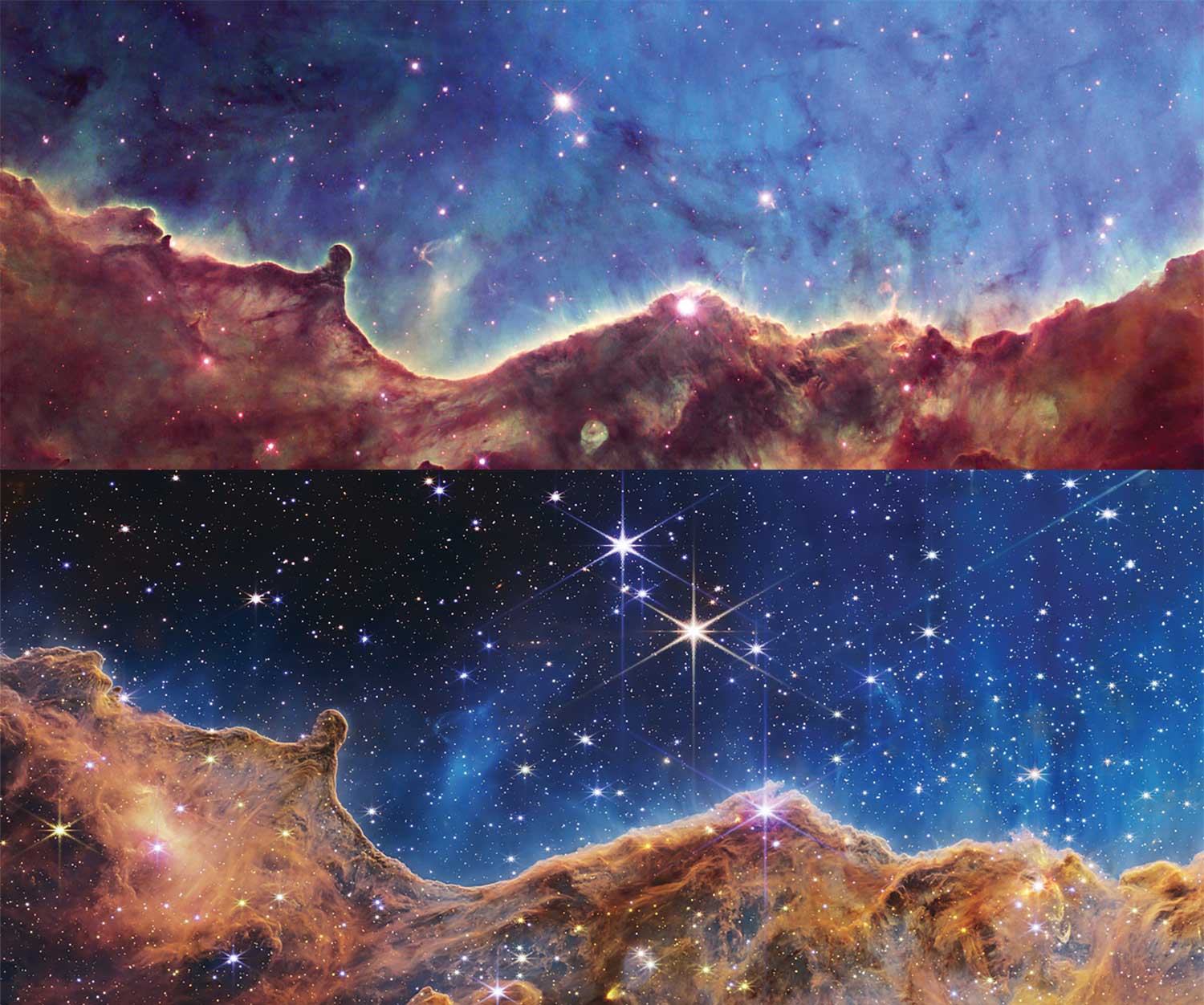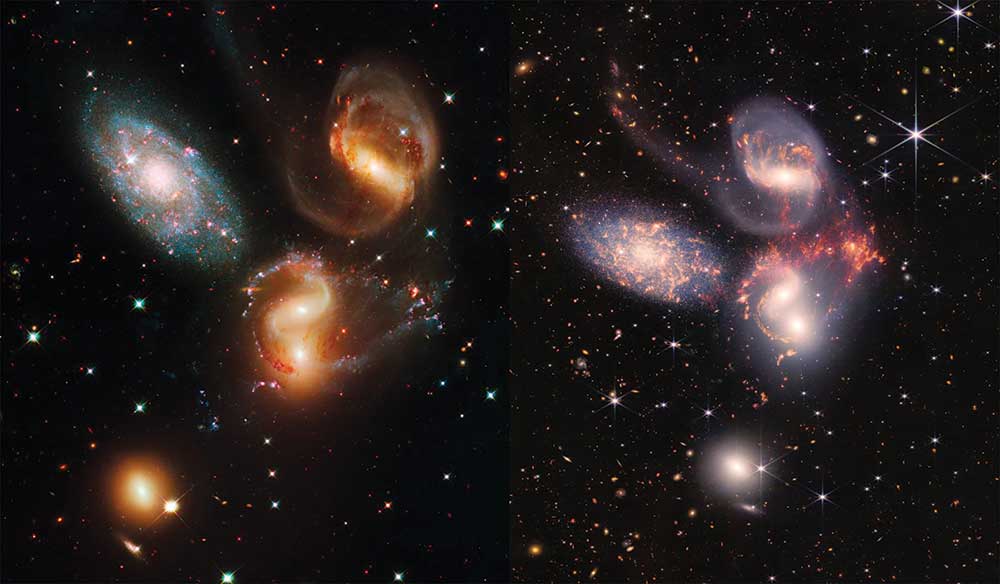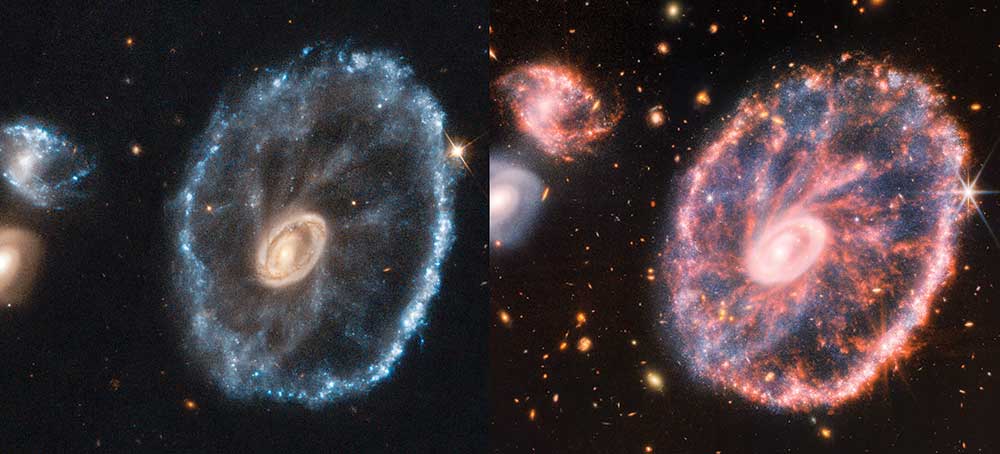Insights from the James Webb Space Telescope
On Christmas Day, 2021, the gold-plated James Webb Space Telescope (JWST) rocketed into space. A month later, on January 24, 2022, it reached its targeted destination, a point in Earth’s orbit some 930,000 miles from Earth. That precise spot, the “L2 Lagrange point,” is where Earth’s gravitational pull on the JWST perfectly balances the Sun’s gravitational pull, allowing the instrument to remain in a stable, fixed position relative to Earth with minimal use of fuel.
For the first few months after its arrival, astronomers devoted full attention to testing and calibrating the jwst’s focus. One of many hopes for this instrument is to deepen and enhance the knowledge gained via the hubble space telescope (hst). Thanks to amazing design advances, this new telescope’s 21-foot diameter main mirror is ideally suited to detect infrared radiation in the deepest regions of space, providing the clearest view yet of the first few billion years of cosmic history.
Initial Findings
For comparison purposes, the jwst’s first sharply focused images, released in july 2022, came from the same areas of the celestial sky as images previously captured by the hst. Why? To determine what new science the jwst might be able to reveal. Much to the thrill of researchers, the initial images—including of the carina nebula and stephan’s quintet—exceeded all expectations (see figures 1 and 2).


The carina nebula is a star-forming nebula (giant cloud of gas and dust). While some of its gas and dust pockets are expanding and pushing against other gas and dust pockets, some are collapsing. The colder pockets of collapsing gas and dust are on their way to becoming stars. These pockets can be seen in carina’s “elephant trunks,” long curvy streams of illuminated gas and dust.
the hst image of carina showed only a few ill-defined elephant trunks. The jwst image clearly reveals several dozen well-defined elephant trunks. Already it has yielded additional details about ongoing star formation. With hundreds of star-forming nebulae in our milky way galaxy, as well as companion galaxies in our local group, the jwst promises to give scientists a more comprehensive and detailed understanding of star formation physics, especially that of stars ranging in mass from 0.08 to 30 times the sun’s mass.
Stephan’s quintet is a visual grouping of five galaxies, only four of which are gravitationally connected. These four are located about 300–400 million light years away from us while the fifth, the bright bluish one to the upper left in figure 2, is a foreground galaxy only 200 million light-years away. The hst’s visible wavelength images are optimal for showing the distribution and structure of stars and star clusters in the galaxies. Infrared wavelengths are optimal for showing the distribution and structure of gas and dust. Analysis of the combined hst and jwst images will yield unprecedented insights into the structure and dynamics of multiple galaxy types.
the major difference between these hst and jwst images may not seem obvious, at first, but a close look at the background makes it clear. The hst reveals a few distant galaxies. The jwst reveals hundreds of them—and at a resolution that identifies what types of galaxies they are.
astronomers were surprised to see the large number of fully formed disk galaxies so early in the universe’s history. However, these disk galaxies are easier to detect at infrared wavelengths than are several other kinds of galaxies in the early universe. Astronomers now anticipate that the jwst’s deeper images from diverse regions of the celestial sky will enable them to discern the true distribution of galaxy types in the early universe.
Anticipation Builds
Soon after the release of the carina nebula and stephan’s quintet images, astronomers focused the jwst on the cartwheel galaxy, also known as pgc 2248. Figure 3 shows the hst’s best image of the cartwheel on the left and the initial jwst image on the right.

the cartwheel galaxy gained its extraordinary structure from a major merger event, the collision of two large galaxies. The hst image shows traces of a few bars of gas and dust that connect the inner part of the galaxy to its giant outer ring of newly formed stars. The jwst image shows all these bars in exceptional detail.
this image comparison tells astronomers that the jwst is poised to help solve remaining mysteries about the physics and dynamics of galaxy merger events. These much-anticipated solutions will give astronomers a more complete understanding of the history of the universe. A more comprehensive history will, in turn, lead to the development of a more detailed and accurate big bang model, a cosmic creation model.
Big Bang Implications?
Not everyone celebrates the development of a more detailed, accurate big bang model, certainly not those disturbed by the big bang’s philosophical/theological implications. Eric lerner, author of the big bang never happened,1 sparked a widely reported rumor that the jwst images contradict the big bang. Lerner continues to defend his claim that electromagnetism, rather than gravity, dominates the dynamics of the universe, despite multiple invalidating measurements.2
lerner seized upon the word “surprising” in many astronomers’ comments to suggest that the images are “not at all what was predicted by theory.”3 he writes:
In the flood of technical astronomical papers published online since july 12, the authors report again and again that the images show surprisingly many galaxies, galaxies that are surprisingly smooth, surprisingly small and surprisingly old. Lots of surprises, and not necessarily pleasant ones. One paper’s title begins with the candid exclamation: “panic!”4
ironically, the preprint paper with “panic!” In its title does not suggest, as lerner implies, that the images raised any panic or serious concern about the big bang set of models.5 the word is used in jest, a clever play on the name of the band, panic! At the disco. The article, “panic! At the disks,” discusses the higher-than-expected number of disk galaxies in the initial jwst images. Its sixteen authors, including rogier windhorst, who solidly endorses the big bang, express confidence that the jwst will deliver a more precise big bang model—in other words, more, not less evidence for the big bang.
the initial jwst images reveal that distant galaxies are smaller than nearby galaxies. Although lerner suggests that this finding is a problem for the big bang, it’s what virtually all big bang models predict. According to big bang cosmology, many of the first stars form clusters, and these first-formed star clusters merge to form larger star clusters. Then the larger star clusters merge, pulling in gas clouds to form dwarf galaxies. Many of the dwarf galaxies, in turn, merge to form larger galaxies. Thus, big bang models predict that while dwarf galaxies will remain the most common galaxy type in the universe, the number and sizes of galaxies will tend to increase as the universe ages.
The financial investment in the jwst reflects the high significance of the information researchers hope to gain from it—cosmic understanding that no other telescope, to date, has been able to access. Its six primary missions are these:
• To determine how the universe’s first stars formed, the relative sizes of the first stars, and the number density of the first stars.
• To determine how and when the first galaxies formed and what types of galaxies first formed.
• To determine in clearer detail how, when, and where stars form today.
• To determine the chemical composition of the atmosphere and hydrosphere of various types of exoplanets.
• To deepen understanding of how planetary systems form and evolve.
• To search giant molecular clouds for carbonaceous molecules in sufficient abundance to serve as “building blocks for the building blocks” of life.
The Heavens Declare
The psalmists and other biblical writers tell us that the heavens reveal not only god’s existence but also god’s glory and majesty, his power and perfection.6 through the time of the biblical patriarchs, prophets, and kings, the night sky was so clear and dark that all the people of the world could see approximately 15,000 stars. Their eyes could take in the full, breathtaking sweep of the milky way galaxy.
Today, the majority of humanity lives in large metropolitan areas. The light and air pollution in these regions blocks our view so effectively that most people struggle to see stars. In the los angeles basin, even on an exceptionally clear night, people may only be able to see about 20–30 objects other than aircraft and satellites. In some asian cities, not a single star is visible. In fact, a visiting student from china pointed to a huge bright light hovering just above the horizon and asked, “what is that?” She had seen the moon only when it stood directly overhead.
while so few people are able to “hear” god’s message by looking up, space telescopes are proclaiming the wonders and beauty of god and his creation to a degree never before seen. We who live in the twenty-first century are uniquely privileged in this respect. We can witness god’s message, written in the heavens, and we can disseminate this message via a vast technological network. With the help of the james webb space telescope, we can anticipate a greater revelation than ever before of who our god is and what he is like. More than to any previous generation, these words apply to us:
For since the creation of the world god’s invisible qualities—his eternal power and divine nature—have been clearly seen, being understood from what has been made, so that people are without excuse. (romans 1:20)
Notes
1. Eric J. Lerner, The Big Bang Never Happened: A Startling Refutation of the Dominant Theory of
the Origin of the Universe (Random House, 1991).
2. Hugh Ross, The Creator and the Cosmos: How the Latest Scientific Discoveries Reveal God, 4th ed.
(RTB Press, 2018), chapter 6.
3. Eric J. Lerner, “The Big Bang Didn’t Happen: What Do the James Webb Images Really Show?” iai
news (Aug. 11, 2022): https://iai.tv/articles/the-big-bang-didnt-happen-auid-2215.
4. Lerner, “The Big Bang Didn’t Happen.”
5. Leonardo Ferreira et al., “Panic! At the Disks: First Rest-Frame Optical Observations of Galaxy
Structure at z > 3 with JWST in the SMACS 0723 Field,” arXiv:2207.09428, version 2 (July 28, 2022):
doi:10.48550/arXiv.2207.09428.
6. Psalm 19:1–4, 50:6, 97:6; Romans 1:19–20, 10:18.
PhD, is an astrophysicist and the founder and president of the science-faith think tank Reasons to Believe (RTB).
Get Salvo in your inbox! This article originally appeared in Salvo, Issue #64, Spring 2023 Copyright © 2026 Salvo | www.salvomag.com https://salvomag.com/article/salvo64/new-eyes-on-the-heavens



















